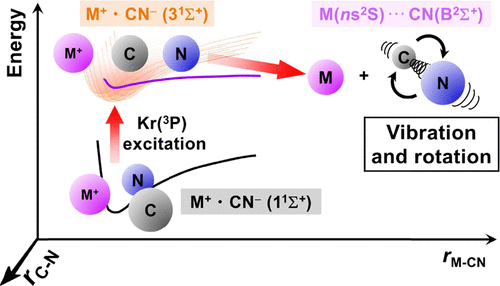当前位置:
X-MOL 学术
›
J. Phys. Chem. A
›
论文详情
Our official English website, www.x-mol.net, welcomes your
feedback! (Note: you will need to create a separate account there.)
Inverted Vibrational and Rotational Excitation of CN(B2Σ+) Produced through Superexcited Ion-Pair States of MCN (M = Na, K, Rb)
The Journal of Physical Chemistry A ( IF 2.7 ) Pub Date : 2020-03-30 , DOI: 10.1021/acs.jpca.9b11634 Hisato Yasumatsu 1 , Gwang-Hi Jeung 2
The Journal of Physical Chemistry A ( IF 2.7 ) Pub Date : 2020-03-30 , DOI: 10.1021/acs.jpca.9b11634 Hisato Yasumatsu 1 , Gwang-Hi Jeung 2
Affiliation

|
This paper reports an energy-partition mechanism in dissociative excitation of alkali cyanide molecules, MCN (M = Rb, K, Na), to produce CN(B2Σ+) and M(ns2S) (n = 5, 4, and 3 for Rb, K, and Na, respectively) in collision with Kr metastable atoms, Krm(3P2,0). Both the vibrational and rotational distributions of CN(B2Σ+) produced in the reactions of RbCN and KCN were inverted as being peaked at v′ = 1 and N′ = 35, respectively, where v′ and N′ are the vibrational and the rotational quantum numbers of CN(B2Σ+), respectively. According to a state crossing model, it was derived that CN(B2Σ+) is produced by predissociation through a superexcited ion-pair state, CN–(31Σ+)·M+(1S), followed by an adiabatic transition to a repulsive state correlating to the dissociation limit of CN(B2Σ+) + M(ns2S). The inverted distributions are driven by structural changes during the excitation and the adiabatic transition. The maximum vibrational population at v′ = 1 originates from a large Franck–Condon overlap between the vibrational wavefunctions of CN–(31Σ+) and CN(B2Σ+) at v′ = 1. The rotational excitation of the CN(B2Σ+) product is explained with changing from a T-shape geometry of MCN in the ground state to a linear one in the superexcited ion-pair state.
中文翻译:

倒振动和CN的转动激发(B 2 Σ +)通过MCN的超激发离子对国家(M =钠,钾,铷)生产的
本文报道在碱金属氰化物分子,MCN(M = RB,K,Na)的,以产生CN(B的离解激发能量分隔机构2 Σ +)和M(Ñ小号2 S)(Ñ = 5,4 ,与Rb,K和Na分别为3和3)与Kr亚稳原子Kr m(3 P 2,0)碰撞。两个CN(B的振动和转动分布2 Σ +在RBCN和KCN的反应产生的)倒置作为被锐化V' = 1和Ñ分别'= 35,其中v '和Ñ'是振动和CN(B的旋转量子数2 Σ +)表示。据的状态下交叉模型,它是得出,CN(B 2 Σ +)是由预离解产生通过超激发离子对状态,CN -(3 1 Σ +)·男+(1个S),接着是绝热过渡到排斥状态相关,以CN(B的解离极限2 Σ +)+ M(ñ小号2 S)。反向分布是由激发和绝热过渡过程中的结构变化驱动的。最大振动人口在v '=从CN的振动波函数之间的大的弗兰克-康登重叠1个始发-(3 1 Σ +)和CN(B 2 Σ +)在v '= 1,CN(B的旋转激励2 Σ +用基态MCN的T形几何形状转变为超激发离子对态的线性MCN解释了产物。
更新日期:2020-03-30
中文翻译:

倒振动和CN的转动激发(B 2 Σ +)通过MCN的超激发离子对国家(M =钠,钾,铷)生产的
本文报道在碱金属氰化物分子,MCN(M = RB,K,Na)的,以产生CN(B的离解激发能量分隔机构2 Σ +)和M(Ñ小号2 S)(Ñ = 5,4 ,与Rb,K和Na分别为3和3)与Kr亚稳原子Kr m(3 P 2,0)碰撞。两个CN(B的振动和转动分布2 Σ +在RBCN和KCN的反应产生的)倒置作为被锐化V' = 1和Ñ分别'= 35,其中v '和Ñ'是振动和CN(B的旋转量子数2 Σ +)表示。据的状态下交叉模型,它是得出,CN(B 2 Σ +)是由预离解产生通过超激发离子对状态,CN -(3 1 Σ +)·男+(1个S),接着是绝热过渡到排斥状态相关,以CN(B的解离极限2 Σ +)+ M(ñ小号2 S)。反向分布是由激发和绝热过渡过程中的结构变化驱动的。最大振动人口在v '=从CN的振动波函数之间的大的弗兰克-康登重叠1个始发-(3 1 Σ +)和CN(B 2 Σ +)在v '= 1,CN(B的旋转激励2 Σ +用基态MCN的T形几何形状转变为超激发离子对态的线性MCN解释了产物。











































 京公网安备 11010802027423号
京公网安备 11010802027423号